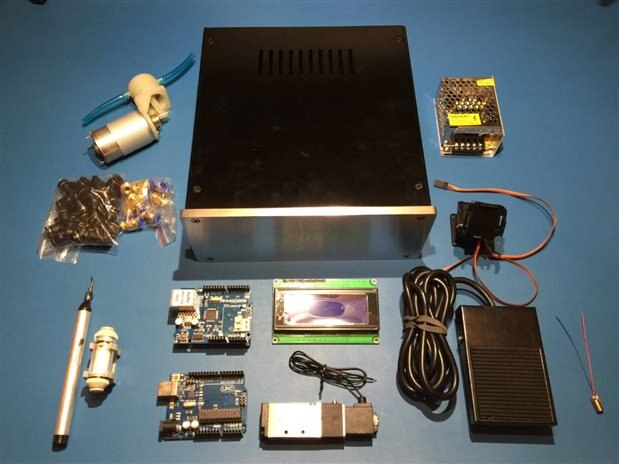There's been a lot of talk on shabaz's blog for his pick and place buddy recently and this gave me the motivation to get on with the very similar project I have been planning. There are some great ideas in that project and the subsequent discussions which will definitely enhance what I was planning and as a result of the inspiration from there have come up with a bunch of additional ideas for things I would like to add to my own. This will be the first blog of several as I go through the design and get it working. I have to fit this in around my main work so it may take a little while before it is complete.
The basic requirements for this project are as follows:
- Provide effective and controllable vacuum pickup for SMD components ranging from small surface mount passives to larger IC's.
- Give guidance to the user about which parts to place in which locations.
- Be reliable and easy to maintain.
- Be self contained (i.e. no need for external vacuum or compressed air source).
- Be relatively quiet in operation.
- Be integrated with my existing systems to ease use.
So today the chassis I ordered to complete the bulk of the kit needed for this project arrived. Whilst there are still things I need to add to the kit as I work through how it's all actually going to work, most of what I will need to get the initial prototype up and running are there. So here is a picture of the bulk of the items:
You can see I have gone for a substantial aluminium chassis. This is personal preference, I like equipment that has a really sturdy and well built feel to it so I went with a premium case. The down side is it makes sorting the mechanical parts of the project more challenging as cutting out holes in that thick brushed aluminium front panel is a lot more difficult than if it were a thin aluminium or plastic panel.
For the initial prototype I have got a cheap PSU from Amazon and I am using an Arduino for the simplicity of getting the thing working. Once it's all working I will probably spin a lot of the electronics into a custom PCB just so I can make it all neater and add in any customisations to the circuit that I want. I'll do a blog covering that process which will lead into some blogs I am considering covering EAGLE and how I set things up etc.
In the above you can see several pieces of the kit, some you'll know what they are for with regards a project of this type, others may be more of a mystery. I'm going to leave you guessing in the comments for a little while on that one just for a little fun 
This was just a brief overview, thanks for reading and let me know your thoughts in the comments!


Top Comments
-

michaelkellett
-
Cancel
-
Vote Up
0
Vote Down
-
-
Sign in to reply
-
More
-
Cancel
-

rachaelp
in reply to michaelkellett
-
Cancel
-
Vote Up
0
Vote Down
-
-
Sign in to reply
-
More
-
Cancel
-

michaelkellett
in reply to rachaelp
-
Cancel
-
Vote Up
0
Vote Down
-
-
Sign in to reply
-
More
-
Cancel
-

rachaelp
in reply to michaelkellett
-
Cancel
-
Vote Up
+1
Vote Down
-
-
Sign in to reply
-
More
-
Cancel
Comment-

rachaelp
in reply to michaelkellett
-
Cancel
-
Vote Up
+1
Vote Down
-
-
Sign in to reply
-
More
-
Cancel
Children